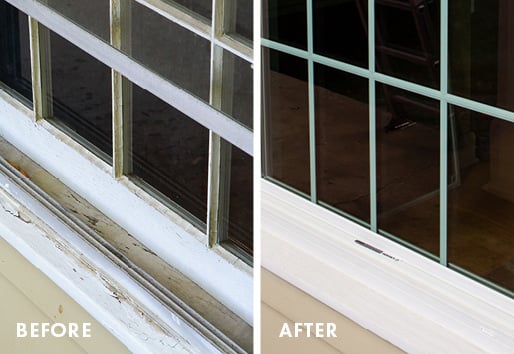Tips
How to clean windows
As the seasons shift, it’s time to learn the best window washing tools and tricks to give your windows a professional shine and keep them operating for the long run.

Windows are one of the most important assets in your home, and you don't want to neglect cleaning and maintaining them. Luckily, you don't have to worry about finding an expensive window cleaning service to get optimal results.
Ready to learn how to make your windows sparkle? To get you started, we’re sharing our top tips along with some professional advice from Micah Nijjar of Micah’s Window Cleaning in the San Francisco Bay Area.
When should I clean my windows?
We recommend window washing twice per year. Cleaning your windows in the fall will clear away debris from the summer days and doing it again in the spring can help get rid of road salt from the winter so you’re always making the most of your natural light.

Early autumn months are the perfect time to wash your windows to achieve perfect views of the fall foliage before the weather gets too cold.
What is the best thing to clean windows with?
There are a lot of window cleaners on the store shelves but making your own cleaner is a simple and cost-effective option that will still leave your glass glistening.
Best DIY window cleaning solution
- Nijjar recommends making your own cleaner by mixing 2 to 3 gallons of water with a 10-second squeeze of dish detergent.
- Vinegar-and-water-based solutions are another effective window cleaner using what you likely already have. Just mix one part distilled white vinegar with one part water in a spray bottle.
Best window cleaning tools
Ready to start gathering your window washing equipment?
- Microfiber cloths are soft and useful at every step so stock up on these.
- A T-bar scrubber or soft sponges, without abrasive coatings, for washing the glass.
- A squeegee for wiping away water. Nijjar recommends a brass one because its extra weight makes it easier to maneuver. If you can’t find brass, aluminum or stainless-steel work well too. If you have very large windows, you might want an 18-inch squeegee.
- A bucket will be needed, if you’re using a homemade soap solution.
- A small brush or whisk broom to sweep away debris at the bottom of the window or in between the glass and the screen.
Some important things to avoid when choosing equipment are razor blades and abrasive cleaners or solvents as these can scratch or damage window glass. Pressure washing is also not advised because it may cause damage to parts of the window.
How do you clean the inside of your windows?
Here’s Nijjar’s proven method for washing the inside of your windows:
- Lay down a towel or drop cloth to catch drips.
- Use a small hand-held vacuum or large paint brush to clear away dirt and spiderwebs from the windowsill. You can fashion a tool for getting tight corners clean by wrapping a cloth around a butter knife. Finally, wipe the sill clean with a damp cloth.
- Being careful not to use too much liquid, begin washing from the top of the window glass using your scrubber and cleaning solution. Rub up-and-down and side-to-side using light to moderate pressure.
- Using a clean, dry cloth, wipe the top and edges of the window to break the bead of water.
- Squeegee the glass dry by starting in one of the top corners and swiping down in a straight line. Keep working your way across the top, wiping your squeegee dry in between strokes. Angle your squeegee slightly so it directs water toward the part of the glass you haven’t squeegeed yet.
- Wipe away any liquid that’s pooled at the bottom of the window.
How do you clean the outside of your windows?
Here’s Nijjar’s pro method for washing the outside of your windows:
- Remove the insect screen and clean it. This leaves time for it to dry while you tackle the rest of the window.
- Brush away dirt and spiderwebs from the window frame and sills using a large paint brush.
- Wipe down the window frame using a damp cloth.
- Beginning at the top and working down, wash glass with your T-bar scrubber and solution. Rub up-and-down and side-to-side using light to moderate pressure.
- If your window is very dirty, you might need to scrub a second time.
- See steps 4 and 5 above.
- Using a dry cloth, detail around the glass to remove any soapy residue left behind. Make sure to use a different, dry part of the rag with each wipe.
- Finally, wipe down the frames.
How do you clean windows without leaving streaks?
The last thing you want is cloudy or streaky windows. Here’s Nijjar's expert advice for achieving completely transparent glass:
- Don’t wash your windows in direct sunlight. The sun will cause your cleaning solution to dry faster than you can wipe it away.
- “The biggest mistake you can ever make is hosing your windows down,” said Nijjar. Even if you have soft water, the mineral content will leave spots behind. Be wary of spraying your windows when using a sprinkler.
- Use this time to check for gaps or damage in your weatherstripping. If you find any damage, we have tips on replacing it here.
- Don’t use newspaper to dry windows as the ink can bleed and discolor the surrounding frame.
- If you can’t reach upper-story windows and feel uncomfortable on a ladder, sometimes the best solution is to hire experts.
Did you know? Tilt-wash double-hung windows tilt inward making it easy to clean the outside of your windows while inside your home. This style of window is especially handy on a second floor, because you don’t need to climb a ladder to clean the windows. Find them available in the 200 Series, 400 Series, A-Series and E-Series.
Did you know? For extra stubborn grime, either toothpaste or mineral spirits can help. Get the details on cleaning with these products in our help center. Note: Neither toothpaste nor mineral spirits should be used on windows with special glass coatings that are more sensitive to abrasives, like HeatLock® coating. Find out if your window has a special glass coating here.
How do you clean windows with insect screens?
If your windows have insect screens, it’s important to give those some attention too. Here’s the recommended method for cleaning windows with screens attached:
- Inspect your insect screens for any torn or damaged mesh to help keep bugs and rodents out of your home. If it’s time to replace, consider upgrading to a TruScene® insect screen, which lets in 25% more light than our conventional aluminum insect screens.
- To clean insect screens, remove them from the window. Wash with a soft bristle brush and mild soapy water. Rinse and allow them to dry.
- After cleaning your screens in the fall, we recommend storing them somewhere to protect them from ice and other winter damage. Doing this can help extend the life of your screens. Get all our tips for winterizing windows.
Don't forget about your patio door insect screens. These should be checked once a year for operation and condition.
More window cleaning FAQs answered
How do I clean my interior window frames?
Wood-framed windows can be dusted with a microfiber cloth in much the same way you dust your woodwork. 100 Series windows are made of Fibrex® material, which can be washed with a solution of mild soap and water and then dried with a clean, soft cloth. Tackle the frames at the same time you clean the glass for a one-and-done approach. Note: It’s not recommended to use alcohol-based glass cleaner on Fibrex® composite material window frames, find more details here.
How do I clean my exterior window frames?
The exteriors of our windows are made of durable materials that can be cleaned with a solution of mild soap and water. Clean them the same way you would the glass: (1) dust off dirt or grime with a dry cloth, (2) wash with soap solution, and (3) rinse off the soap and water and dry or squeegee.
How do I clean my window hardware?
Most hardware can be cleaned by using a soft cloth with a mild soap-and-water solution. Note: Chrome and bronze (both oil-rubbed and distressed) hardware finishes require different cleaning approaches — find the details in our help center.
How do I clean my window grilles?
Grilles can be cleaned with a brush and a solution of mild soap and water at the same time you clean window glass. If you have interior-only grilles, they may be removable for easy cleaning. To find out, gently try to lift them away from the glass. Removable grilles can be laid on a clean, flat surface for easy cleaning. Be sure to let them dry before reinstalling.
What else needs maintaining?
For smooth operation, window and door hardware or other moving components can be lubricated. Dry lubricant spray is recommended and available through our parts store.
Up next


